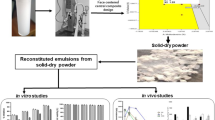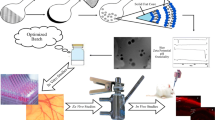Abstract
The objectives of the present investigations are (1) to envisage a risk assessment plan for nonphospholipid-based topical ophthalmic emulsions with the help of failure mode and effect analysis (FMEA), (2) to screen the risky formulation and process variables by the Taguchi design, (3) to optimize systematically an emulsion formula by face-centered central composite design (CCD), (4) to incorporate cyclosporin A (0.05 or 0.1% w/w) into the optimized emulsions and predict the in vitro drug release kinetic via a particle diffusion-controlled mathematical model equation, and (5) to assess the emulsion’s toxicity using in vitro hemolysis study. Through the risk priority number (RPN) scores of FMEA, half-normal and Pareto charts of the Taguchi design, 3D-response surface graphs, and overlay plots of CCD, the emulsion formula was systematically optimized. Irrespective of the two different drug loadings into optimized emulsions, the drug entrapment efficiency values ranged from 73.20 ± 0.13 to 74.42 ± 0.15%. The film diffusion or ion-exchange process fails to interpret the in vitro drug release kinetic profile. A permissible percentage hemolysis value of above 10% but below 25% guidance was observed for emulsions with or without cyclosporin A. The systematically optimized phospholipidless ophthalmic emulsions could further be exploited commercially for managing dry-eye syndrome.




Similar content being viewed by others
References
. Q8(R2) pharmaceutical development. Part I: pharmaceutical development, and Part II: annex to pharmaceutical development. http://www.ich.org/fileadmin/Public_Web_Site/ICH_Products/Guidelines/Quality/Q8_R1/Step4/Q8_R2_Guideline.pdf (2009). Accessed date 1 Aug 2019.
ICH. Q9 quality risk management. http://www.ich.org/fileadmin/Public_Web_Site/ICH_Products/Guidelines/Quality/Q9/Step4/Q9_Guideline.pdf (2005). Accessed date1 Aug 2019.
ICH. Q10 pharmaceutical quality system. http://www.ich.org/fileadmin/Public_Web_Site/ICH_Products/Guidelines/Quality/Q10/Step4/Q10_Guideline.pdf (2008). Accessed date 1 Aug 2019.
Pflugfelder SC. Antiinflammatory therapy for dry eye. Am J Ophthalmol. 2004;137:337–42.
Fruman DA, Klee CB, Bierer BE, Burakoff SJ. Calcineurin phosphatase activity in T lymphocytes is inhibited by FK 506 and cyclosporin A. Proc Natl Acad Sci U S A. 1992;89:3686–90.
Bron AJ, de Paiva CS, Chauhan SK, Bonini S, Gabison EE, Jain S, et al. TFOS DEWS II pathophysiology report. Ocul Surf. 2017;15:438–510. https://doi.org/10.1016/j.jtos.2017.05.011.
Fahmy R, Kona R, Dandu R, Xie W, Claycamp G, Hoag SW. Quality by design I: application of failure mode effect analysis (FMEA) and Plackett-Burman design of experiments in the identification of “main factors” in the formulation and process design space for roller-compacted ciprofloxacin hydrochloride immediate-release tablets. AAPS PharmSciTech. 2012;13(4):1243–54. https://doi.org/10.1208/s12249-012-9844-x.
Negi P, Singh B, Sharma G, Beg S, Katare OP. Biocompatible lidocaine and prilocaine loaded-nanosized emulsion system for enhanced percutaneous absorption: QbD-based optimisation, dermatokinetics and in vivo evaluation. J Microencapsul. 2015;32(5):419–31. https://doi.org/10.3109/02652048.2015.1046513.
Yu Y, Chen D, Li Y, Yang W, Tu J, Shen Y. Improving the topical ocular pharmacokinetics of lyophilized cyclosporine A loaded micelles: formulation, in vitro and in vivo studies. Drug Delivery. 2018;25(1):888–99. https://doi.org/10.1080/10717544.2018.1458923.
Wang LX, He HB, Tang X, Shao RY, Chen DW. A less irritant norcantharidin lipid microsphere: formulation and drug distribution. Int J Pharm. 2006;323:161–7.
Moses RA. Adler’s physiology of the eye clinical application. St. Louis, MO: The C.V. Mosby Company (1981) 16-23.
Tamilvanan S, Kumar BA. Influence of acetazolamide loading on the (in vitro) performances of non-phospholipid-based cationic nanosized emulsion in comparison with phospholipid-based anionic and neutral-charged nanosized emulsions. Drug Dev Ind Pharm. 2011;37(9):1003–15. https://doi.org/10.3109/03639045.2011.555407.
Rabinovich-Guilatt L, Couvreur P, Lambert G, Goldstein D, Benita S, Dubernet C. Extensive surface studies help to analyse zeta potential data: the case of cationic emulsions. Chem Phys Lipids. 2004;131:1–13.
Tamilvanan S, Khoury K, Gilhar D, Benita S. Ocular delivery of cyclosporin A. I. Design and characterization of cyclosporin A-loaded positively-charged submicron emulsion. STP Pharm Sci. 2001;11:421–6.
Tamilvanan S, Kumar BA, Senthilkumar SR, Baskar R, Sekharan TR. Stability assessment of injectable castor oil-based nano-sized emulsion containing cationic droplets stabilized by poloxamer-chitosan emulsifier films. AAPS PharmSciTech. 2010;11:904–9.
Woitiski CM, Veiga F, Ribiero A, Neufeld R. Design for optimization of nanoparticles integrating biomaterials for orally dose insulin. Eur J Pharm Biopharm. 2009;73:25–33.
Motwani SK, Copra S, Talegaonkar S, Kohli K, Ahmad FJ, Khar RK. Chitosan-sodium alginate nanoparticles as submicroscopic reservoirs for ocular delivery: formulation, optimization and in vitro characterization. J Pharmacokinet Biopharm. 2008;68:513–25.
Joglekar AT. Product excellence through design of experiments. Cereal Foods World. 1987;32:857–68.
Jumaa M, Müller BW. The effect of oil components and homogenization conditions on the physicochemical properties and stability of parenteral fat emulsions. Int J Pharm. 1998;163:81–9.
Tang SY, Manickam S, Wei TK, Nashiru B. Formulation development and optimization of a novel Cremophor EL-based nanoemulsion using ultrasound cavitation. Ultrason Sonochem. 2012;19:330–45.
Cegnar M, Kos J, Kristl J. Cystatin incorporated in poly(lactide-co-glycolide) nanoparticles: development and fundamental studies on preservation of its activity. Eur J Pharm Sci. 2004;22:357–64.
Müllar RH. Colloidal carriers for controlled drug delivery and targeting: modification, characterization and in vivo distribution. Wiss Verl-Ges: Stuttgart, Germany; 1990.
Tamilvanan S. Formulation of multifunctional oil-in-water nanosized emulsions for active and passive targeting of drugs to otherwise inaccessible internal organs of the human body. Int J Pharm. 2009;381:62–76.
Hagigit T, Nassar T, Behar-Cohen F, Lambert G, Benita S. The influence of cationic lipid type on in-vitro release kinetic profiles of antisense oligonucleotide from cationic nanoemulsions. Eur J Pharm Biopharm. 2008;70:248–59.
Amin K, Dannenfelser R. In vitro hemolysis: guidance for the pharmaceutical scientist. Eur J Pharm Sci. 2006;95:1173–6.
Funding
The authors would like to thank the Department of Biotechnology (DBT), Govt. of India, for providing financial support under Nanotechnology grant (Sanction No. 102/IFD/SAN/2383/2018-2019, Date: Sept. 19, 2018) to run this project.
Author information
Authors and Affiliations
Corresponding author
Ethics declarations
The experimental procedure of the hemolysis test was approved by the Ethics Review Committee of Guwahati Neurological Research Center (GNRC) Hospital, Guwahati, Assam, India.
Conflict of Interest
The authors declare that they have no competing interest.
Additional information
Publisher’s Note
Springer Nature remains neutral with regard to jurisdictional claims in published maps and institutional affiliations.
Rights and permissions
About this article
Cite this article
Rahman, S.N.R., Pawde, D.M., Katari, O. et al. Systematic Optimization, In Vitro Drug Release, and Preliminary Nonclinical Toxicity Assessment of Nonphospholipid-Based Topical Ophthalmic Emulsions Containing 0.05 or 0.1% w/w Cyclosporin A for Dry-Eye Syndrome Management. AAPS PharmSciTech 21, 36 (2020). https://doi.org/10.1208/s12249-019-1587-5
Received:
Accepted:
Published:
DOI: https://doi.org/10.1208/s12249-019-1587-5




